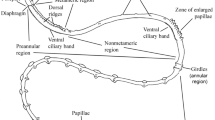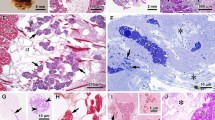Abstract
Ocelli of several species of acoels flatworms in the genera Convoluta, Praesagittifera, Symsagittifera, and Amphiscolops were examined by transmission electron microscopy. Each ocellus consisted of a slightly concave pigment cell containing spindle-shaped platelets and several sensory cells, one in close contact with the pigment cell and the others separated from it by the former. These ocelli appeared unlike photoreceptors in most turbellarians in their lack of either rhabdomeres or cilia and in having platelets in the pigment cell. In species of Amphiscolops, the pigment cell had no other secretory inclusions than the platelets; the other species had characteristic pigment granules in addition to the platelets. In Praesagittifera naikaiensis (Yamasu) the primary sensory cell was penetrated by branching processes from the other sensory cells; A. langerhansi(?) may have similar processes, but the other species did not. Experimental ablation and subsequent regeneration of the ocelli of P. naikaiensis produced behavior consistent with their being photoreceptive. Two kinds of sagittocysts, one up to 40 µm long and other 8 µm long, were found in P. shikoki Kostenko & Mamkaev. These were thick-walled secretory products with a protrusible filament, and their association with the reproductive organs of the worm indicate a role in copulation.
Similar content being viewed by others
References
Duke-Elder, S., 1958. System of ophthamology. Vol. 1. Henry Kimpton, London.
Ehlers, U., 1985. Das Phylogenetische System der Plathelminthes. Gustav Fischer, Stuttgart, 317 pp.
Hyman, L. H., 1939. Acoel and polyclad Turbellaria from Bermuda and the Sargassum. Bull. Bingham oceanogr. Coll. 7: 1–26 + 9 pl.
Hyman, L. H., 1951. The invertebrates. II. Platyhelminthes and Rhynchocoela. The acoelomate Bilateria. McGrawHill, New York, 550 pp.
Kato, K., 1947. A new species of the Convolutidae (Acoela, Turbellaria). Seibutu Suppl. 1: 58–62. [In Japanese]
Kato, K., 1951. Convoluta, an acoelous turbellarian, destroyed the edible clam. Misc. Rep. Re. Inst. Nat. Res. Nos., pp. 19–21, 64–67.
Kawaguti, S., 1966. Electron microscopy on the mantle of the giant clam with special references to zooxanthellae and iridophores. Biol. J. Okayama Univ. 12: 81–92.
Kawaguti, S., 1981. Eyes of the giant clam. Bull. Kawasaki Paramed. Coll. 1: 1–8.
Kawaguti, S. & K. Mabuchi, 1969. Electron microscopy on the eyes of the giant clam. Biol. J. Okayama Univ. 15: 87–100.
Keeble, F., 1910. Plant-animals: a study in symbiosis. Cambridge University Press, London, 163 pp.
Kostenko, A. G. & Yu. V. Mamkaev, 1990. The position of ‘green convoluts’ in the system of acoel turbellarians (Turbellaria, Acoela). 1. Simsagittifera gen. n. 2. Sagittiferidae fam. n. Zool. Zh. 69(6): 11–21; 69(7): 5–16.
Mamkaev, Yu. V., 1971. On the Convoluta (Turbellaria, Acoela) from the South Primorsk. Fauna and Flora of the Possjet Bay of the Sea of Japan. Explorations of the Fauna of the Seas VIII (X VI). Acad. Sci. USSR Zool. Inst., pp. 31–54.
Mamkaev, Yu. V. & A. G. Kostenko, 1991. On the phylogenetic significance of sagittocysts and copulatory organs inacoel turbellarians. Hydrobiologia 227/Dev. Hydrobiol. 69: 307–314.
Milne, L. J. & M. J. Milne, 1965. Invertebrate photoreceptors. Rad. Biol. 3: 621–692.
Popova, N. V. & Yu. V. Mamkaev, 1985. Ultrastructure and primitive features of the eyes of Convoluta convoluta (Turbellaria Acoela). Dokl. Akad. Nauk SSSR 283: 756–759.
Rieger, R. M., S. Tyler, J. P. S. Smith, III & G. E. Rieger, 1990. Platyhelminthes: Turbellaria. In F. W. Harrison & B. J. Bogitsh (eds), Platyhelminthes and Rhynchocoela, Vol. 3 in F. W. Harrison (ed), Microscopic anatomy of invertebrates. Wiley-Liss, New York: 7–140. Sopott-Ehlers, B., 1991. Comparative morphology of photoreceptors in free-living Plathelminthes — a survey. Hydrobiologia 227/Dev. Hydrobiol. 69: 231–239.
Yamasu, T., 1982. Five new species of acoel flat worms from Japan. Galaxea 1: 29–43.
Yamasu, T. & A. Okazaki, 1987. Preliminary faunal list of acoel turbellarian species from the Ryuku Islands. Galaxea 6: 61–68.
Yamasu, T., Y. Ichimiya & T. Kanda, 1979. The structure and function of the ocelli of an acoel flatworm. Photomed. Photobiol. 1: 141–142.
Yoshida, M., 1979. Extraocular photoreception. In H. Autrum (ed), Handbook of Sensory Physiology vol VII/6A Comparative Physiology and Evolution of Invertebrate Photoreceptors. Springer Verlag, New York: 581–640.
Author information
Authors and Affiliations
Rights and permissions
About this article
Cite this article
Yamasu, T. Fine structure and function of ocelli and sagittocysts of acoel flatworms. Hydrobiologia 227, 273–282 (1991). https://doi.org/10.1007/BF00027612
Issue Date:
DOI: https://doi.org/10.1007/BF00027612




